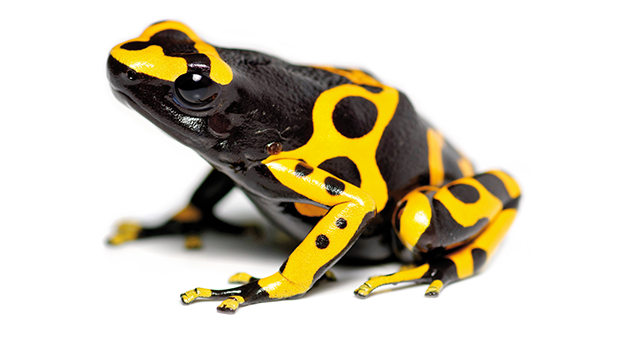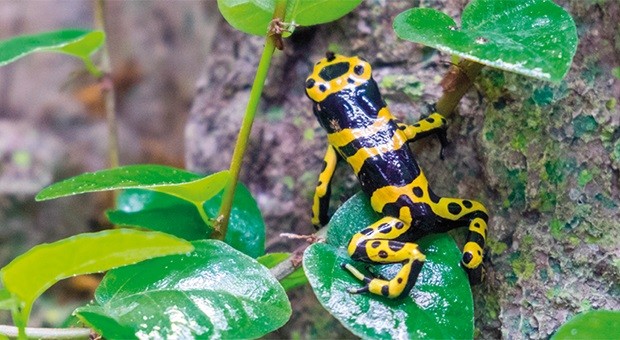Di un bel colore giallo acceso, il piccolo anfibio colombiano è tra gli animali più velenosi esistenti sulla Terra
Tanto bella quanto velenosa, la rana dorata o rana freccia (Phyllobates terribilis) è un piccolo anfibio che vive nelle foreste pluviali delle Ande occidentali colombiane. La pelle è generalmente tinta di un giallo acceso, talvolta leggermente maculata sulla testa in base a micro-variazioni geografiche, e il suo aspetto è considerato un classico esempio di aposematismo, ovvero la colorazione di una parte più o meno estesa del corpo a fini di avvertimento contro possibili predatori.
Tra i più tossici del mondo
La rana freccia, infatti, è densamente ricoperta di un velenoso alcaloide che impedisce ai nervi di trasmettere impulsi, lasciando i muscoli tetanizzati: questo causa nelle vittime insufficienza respiratoria, insufficienza cardiaca o fibrillazione, quindi la morte.
Tra gli animali attualmente studiati, la rana freccia è senza dubbio uno dei più tossici. Secondo gli esperti, la maggior parte del veleno secreto viene sintetizzato dalle foglie di media tossicità di cui si nutrono alcune delle sue prede; un insetto cruciale in questo senso sarebbe un piccolo coleottero della famiglia Melyridae, che effettivamente produce le stesse tossine trovate nella rana, le batracotissine (BTX).
A dimostrazione di questa teoria, è stato rilevato che gli esemplari di rana freccia cresciuti in cattività, quindi con un regime alimentare differente, non risultano essere velenosi. La batracotossina è la più potente neurotossina non peptidica conosciuta; la quantità presente sulla pelle della rana freccia è sufficiente per uccidere dieci persone di peso medio!
Al veleno della rana colombiana non esiste ancora nessun antidoto; l'unica creatura che sembra esserne immune è una specie di serpente.
Per proteggersi dalla sua stessa arma, il piccolo anfibio giallo pare aver sviluppato una mutazione genetica che annullerebbe gli effetti letali del suo veleno; dopo vari esperimenti, gli scienziati hanno individuato tale mutazione nell'amminoacido N1584T. Nonostante il potenziale letale della sua pelle, la rana dorata in genere non supera i quattro centimetri di lunghezza. Gli esemplari femmina sono solitamente poco più grossi dei maschi, ed è questa l'unica differenza di genere visibile. Durante il corteggiamento il maschio attira la femmina con forti richiami in un luogo adatto alla riproduzione, di solito una foglia o una pietra.
Dopo che la femmina ha deposto le uova – di solito non più di una ventina – esse vengono fecondate dal maschio; una volta schiuse, il maschio si carica le larvette sulla schiena e le colloca in uno specchio d'acqua dopo qualche giorno, quando ormai sono diventate girini. Al momento lo stato di conservazione della rana risulta in pericolo. Come nella maggior parte dei casi, le cause sono da imputarsi per lo più all'intervento dell'uomo.
Pare infatti che gli indigeni americani usassero il suo veleno per rendere ancor più letali le loro frecce; per far sì che gli anfibi secernessero più liquido, i nativi erano soliti avvicinarle al fuoco o infilzarle in gola con un bastoncino, in modo che sentissero un maggior senso di pericolo. In passato la rana dorata era molto diffusa anche a Panama e in alcune zone del Costa Rica, dove era considerata un simbolo porta fortuna; lì si è rapidamente estinta alla fine XXI secolo per via di una virulenza da funghi.
Laura Spataro
Traduzione in lingua inglese a opera di ViceVersa Group
The golden poison frog: the most ultra dangerous of the animal world. With its attractive bright yellow colour, this small Colombian amphibian is one of the most poisonous animals in the world
The golden frog or golden poison frog (phyllobates terribilis) is as beautiful as it is poisonous, a small amphibian which lives in the rain forests of Colombia’s western Andes. Its skin is generally bright yellow, sometimes slightly marked on its head on the basis of geographical micro variations and its appearance is considered a classic example of aposematic colouring, namely the colour of a part of the body which varies in size to warn off potential predators.
One of the world's most toxic
The golden poison frog is, in fact, densely coated with a poisonous alkaloid which blocks the nerves from transmitting impulses, leaving muscles in inactive contraction and causing breathing or heart failure or fibrillation and thus death. Of the animals studied to date, the golden poison frog is undoubtedly one of the most poisonous.
Experts believe that the majority of the poison secreted is synthesised from the leaves of medium toxicity which some of its prey feed off. A key insect in this sense is a small beetle from the Melyridae family which effectively produces the same toxins as the frog, batrachotoxin (BTX).
Examples of frogs raised in captivity have demonstrated this theory: with a different diet these are not poisonous. Batrachotoxin is the most powerful known non-peptidic neurotoxin. The quantities present on the frog’s skin are capable of killing ten people of average weight!
There is no antidote to this Colombian frog’s poison and the only creature immune to it would seem to be a species of snake. To protect itself against its own poison, this small yellow amphibian would seem to have developed a genetic mutation which cancels out the lethal effects of its poison. After a range of experiments scientists have identified this mutation in the amino acid N1584T.
Despite the lethal potential of its skin, the golden frog is not generally larger than four centimetres in length. Females are generally larger than males and this is the only visible difference.
During courting males attract females with loud calls in a place suitable for reproduction, generally a leaf or stone.
After females have laid their eggs - generally no more than 20 - these are fertilised by males. When they open males put the larvae on their backs and place them in water after a few days, at which point they are tadpoles. These frogs are currently endangered.
Like the majority of such creatures, this is largely due to human action. It would, in fact, seem that the Native Americans once used its poison to make their arrows even more lethal.
To get the amphibians to secrete more liquid they generally took them to fire or stuck a stick down their throats in order to provoke a greater sense of danger. In the past golden frogs were also very common in Panama and certain zones of Costa Rica where they were considered talismans. They soon became extinct there at the beginning of the 21st century as a result of a fungal infection.
















